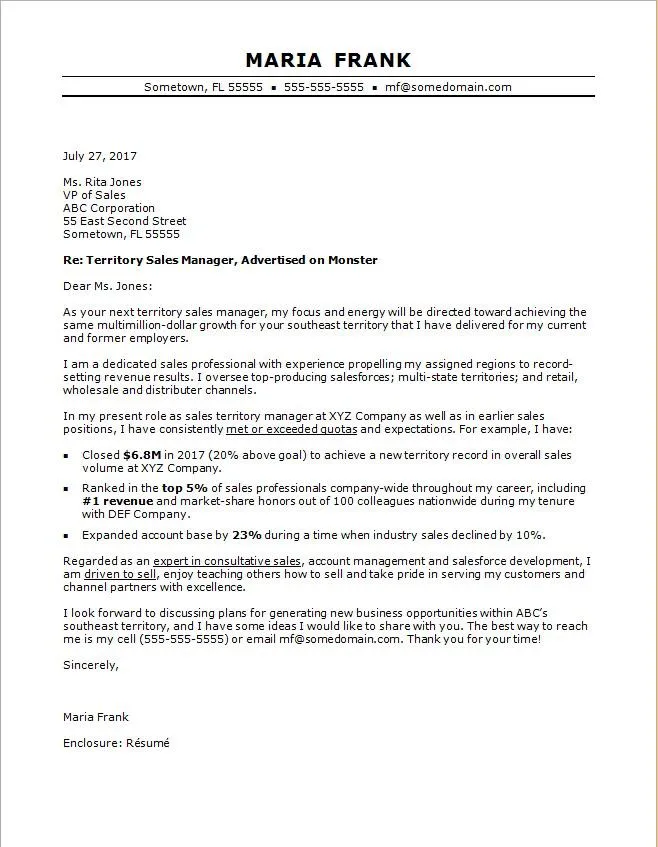What is a Sales Cover Letter
A sales cover letter is a crucial document that accompanies your resume when applying for sales positions. It serves as your first impression, providing an opportunity to introduce yourself, highlight your relevant skills and experience, and express your enthusiasm for the role and the company. Unlike a resume, which is a factual summary of your professional history, a cover letter allows you to tell a story, connecting your qualifications to the specific job requirements and demonstrating why you are the ideal candidate. It’s a chance to showcase your personality, communication skills, and genuine interest in the opportunity. This is your first step to your dream job. A well-crafted sales cover letter can significantly increase your chances of getting an interview and ultimately landing the job.
Why Sales Cover Letters are Important
Sales cover letters are important for several reasons. Firstly, they allow you to personalize your application and tailor it to the specific job and company. Generic applications often get overlooked, but a customized cover letter demonstrates that you’ve taken the time to understand the role and the organization’s needs. Secondly, cover letters provide an opportunity to highlight your key skills and accomplishments in a more narrative format. While your resume lists your experience, your cover letter allows you to elaborate on your achievements, providing context and demonstrating how you’ve delivered results in the past. Furthermore, a compelling cover letter can showcase your communication skills, which are critical in sales. Your ability to write clearly, persuasively, and professionally can make a significant difference in how your application is perceived. Finally, a cover letter provides a space to express your enthusiasm for the role and the company, demonstrating your genuine interest and motivation to join their team. Remember that the companies want to know why you fit the role and company.
Key Components of a Sales Cover Letter
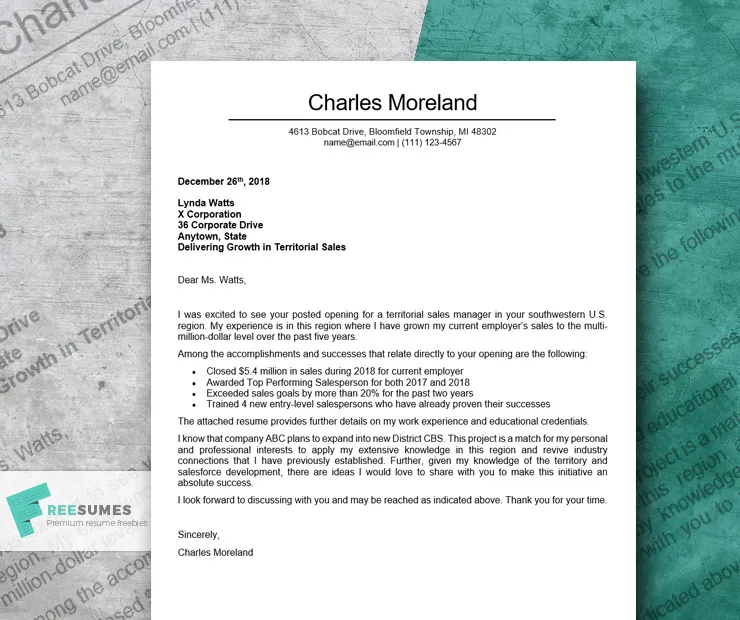
A strong sales cover letter typically includes several key components. Begin with your contact information, followed by the date and the recipient’s contact information. The salutation should be professional and address the hiring manager or the relevant person by name whenever possible. The opening paragraph should immediately grab the reader’s attention, stating the position you’re applying for and briefly mentioning where you found the job posting. The body of your letter should highlight your relevant skills and experience, providing specific examples of your accomplishments and quantifying your results whenever possible. Tailor the content to the job description, emphasizing the skills and experiences that align with the employer’s needs. Conclude with a strong call to action, expressing your interest in an interview and thanking the hiring manager for their time and consideration. Always proofread your letter carefully before submitting it to ensure it is free of errors and is well-formatted. Make sure you have a strong opening to make the hiring manager interested in your application.
Contact Information and Salutation
Your contact information should be clearly presented at the top of your cover letter. Include your full name, phone number, email address, and optionally, your LinkedIn profile URL. This information ensures that the hiring manager can easily contact you. The date should follow, along with the recipient’s contact information, including the hiring manager’s name, title, company name, and address. Always use a professional salutation, such as “Dear Mr./Ms./Mx. [Last Name]” if you know the hiring manager’s name. If you’re unsure, use “Dear Hiring Manager” or “Dear [Company Name] Hiring Team.” Avoid generic salutations like “To Whom It May Concern,” as they can make your application seem impersonal. Always double-check the spelling of the recipient’s name and title to avoid any errors. It is important that the hiring manager finds your application professional. A small mistake will decrease your chances to get the job.
Highlighting Your Skills and Achievements
In the body of your sales cover letter, focus on highlighting your key skills and achievements that align with the job requirements. Review the job description carefully and identify the skills and experiences the employer is seeking. Provide specific examples of how you’ve demonstrated those skills in previous roles. Use action verbs to describe your accomplishments, such as “achieved,” “exceeded,” “managed,” and “developed.” Instead of simply listing your responsibilities, focus on the results you achieved. For example, if the job description emphasizes the need for strong communication skills, describe a situation where you successfully communicated with clients, resolved conflicts, or closed a deal. If they are looking for a person with closing sales skills, describe a situation where you exceeded the sales target.
Quantifying Your Accomplishments
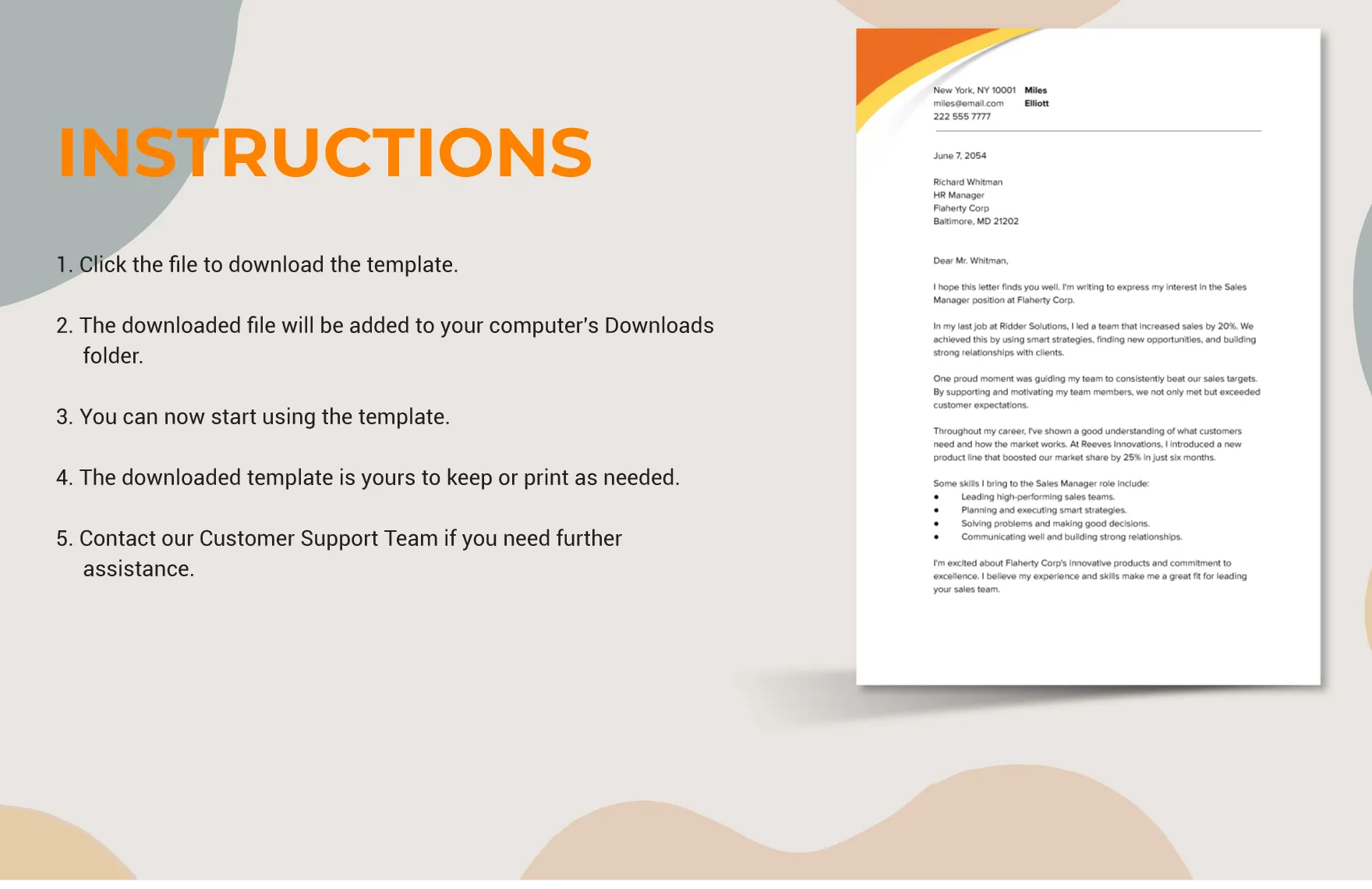
Quantifying your accomplishments is a powerful way to demonstrate your impact and make your cover letter more persuasive. Whenever possible, use numbers and data to illustrate your achievements. Instead of saying “Increased sales,” say “Increased sales by 20% in one year.” Instead of saying “Managed a team,” say “Managed a team of 10 sales representatives, consistently exceeding quarterly targets.” Using specific metrics makes your accomplishments more tangible and credible. If you have received any awards or recognitions, mention them in your cover letter. For example, “Awarded ‘Salesperson of the Year’ for exceeding sales targets by 30%.” Quantifying your accomplishments not only demonstrates your success but also shows that you understand how to measure results and drive performance. By providing these numbers, the hiring manager will be able to analyze your performance better and see what you are capable of doing for their company.
Tailoring Your Cover Letter to the Job
Tailoring your cover letter to each job you apply for is essential for showcasing your suitability for the role. Generic cover letters that are sent to multiple companies often fail to make a strong impression. Instead, carefully review the job description and identify the specific requirements and qualifications the employer is looking for. Use the job description as a guide to highlight the skills, experiences, and accomplishments that align with the role’s needs. Customize your cover letter by using keywords from the job description and providing specific examples of how you’ve demonstrated those skills in the past. Research the company and their values to tailor your letter to their culture and mission. A personalized cover letter demonstrates that you have taken the time to understand the job and the company and that you are genuinely interested in the opportunity. Be sure to adapt the letter depending on the job requirements.
Researching the Company
Before writing your sales cover letter, take the time to research the company. This research can provide valuable insights that you can use to tailor your letter and demonstrate your genuine interest in the organization. Visit the company’s website to learn about their products or services, their mission, their values, and their recent news and achievements. Explore their social media profiles, such as LinkedIn, Facebook, and Twitter, to gain a better understanding of their brand and culture. If possible, research the hiring manager or the person who will be reviewing your application. Learn about their background, experience, and interests. Tailor your cover letter to align with the company’s values and highlight how your skills and experience can contribute to their goals. Mentioning specific company initiatives or products in your letter shows that you’ve done your homework and are genuinely interested in joining their team. A bit of research can go a long way to get you hired.
Demonstrating Enthusiasm and Fit
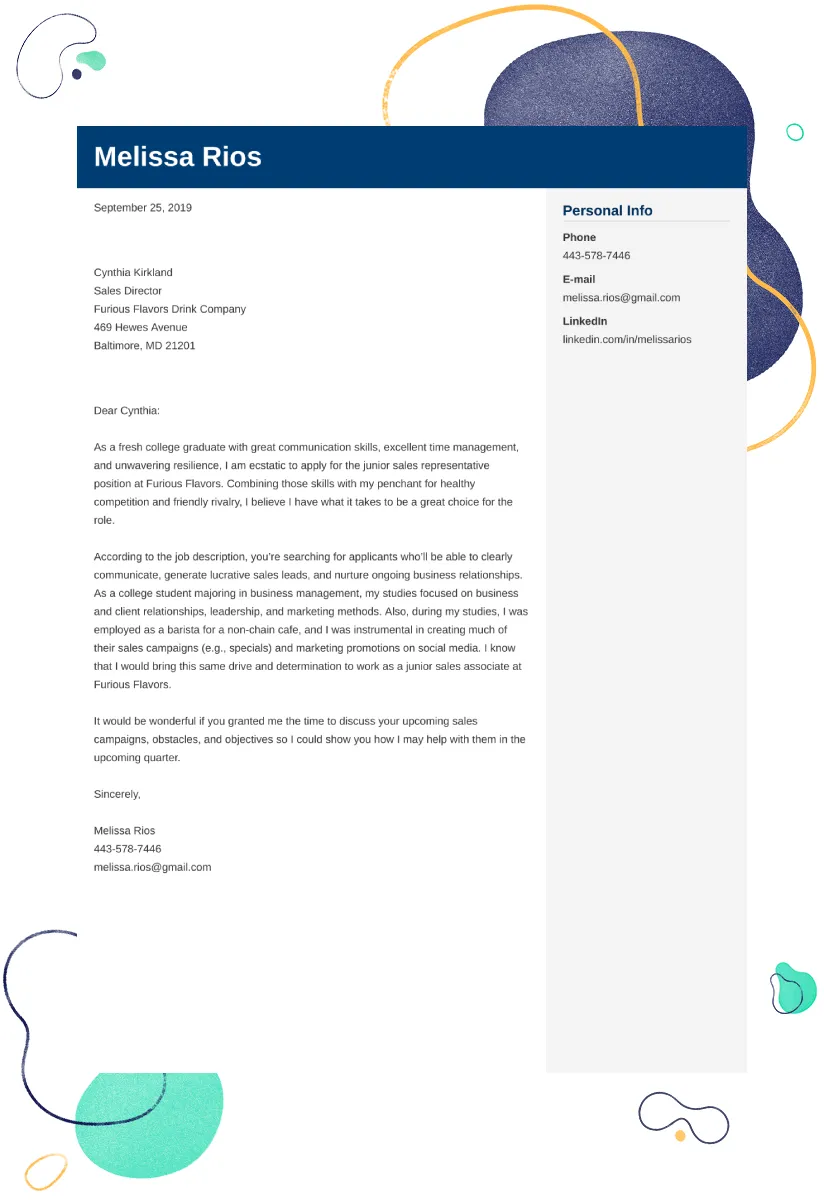
Demonstrating your enthusiasm for the role and the company is crucial for making a positive impression. Express your genuine interest in the opportunity and explain why you are excited about the prospect of joining their team. Mention specific aspects of the job or the company that appeal to you. Highlight how your skills and experience align with the role’s requirements and demonstrate your understanding of the company’s mission and values. Show how you can contribute to their success. Explain why you are the right fit. Your enthusiasm can make a difference in a hiring manager’s decision. It can show that you are motivated to take the job and want to succeed. A strong and enthusiastic candidate has better chances to get hired.
Writing a Strong Call to Action
Conclude your sales cover letter with a strong call to action. Clearly state your interest in an interview and express your enthusiasm for discussing your qualifications further. Thank the hiring manager for their time and consideration. Provide your contact information again, and make it easy for them to reach you. Avoid generic phrases like “I look forward to hearing from you.” Instead, use a more proactive approach, such as “I am eager to discuss how my skills and experience can contribute to [Company Name]’s success and am available for an interview at your earliest convenience.” or “Thank you for your time. I am excited about the opportunity to contribute to your team. I look forward to hearing from you soon.” A strong call to action encourages the hiring manager to take the next step in the hiring process. It shows your confidence and your eagerness to move forward.
Formatting Your Sales Cover Letter
Formatting your sales cover letter correctly is just as important as the content. Use a professional font, such as Times New Roman, Arial, or Calibri, with a font size between 10 and 12 points. Use single-spacing within paragraphs and double-spacing between paragraphs. Keep your letter concise, ideally no more than one page. Use clear and easy-to-read formatting, including headings, bullet points, and white space to break up the text and make it visually appealing. Use consistent formatting throughout the letter. Ensure that the letter is well-aligned and that there are no formatting errors. A well-formatted cover letter demonstrates your attention to detail and professionalism, which are essential qualities for a sales role. Always make sure the cover letter looks professional and that it is well organized.
Proofreading and Editing
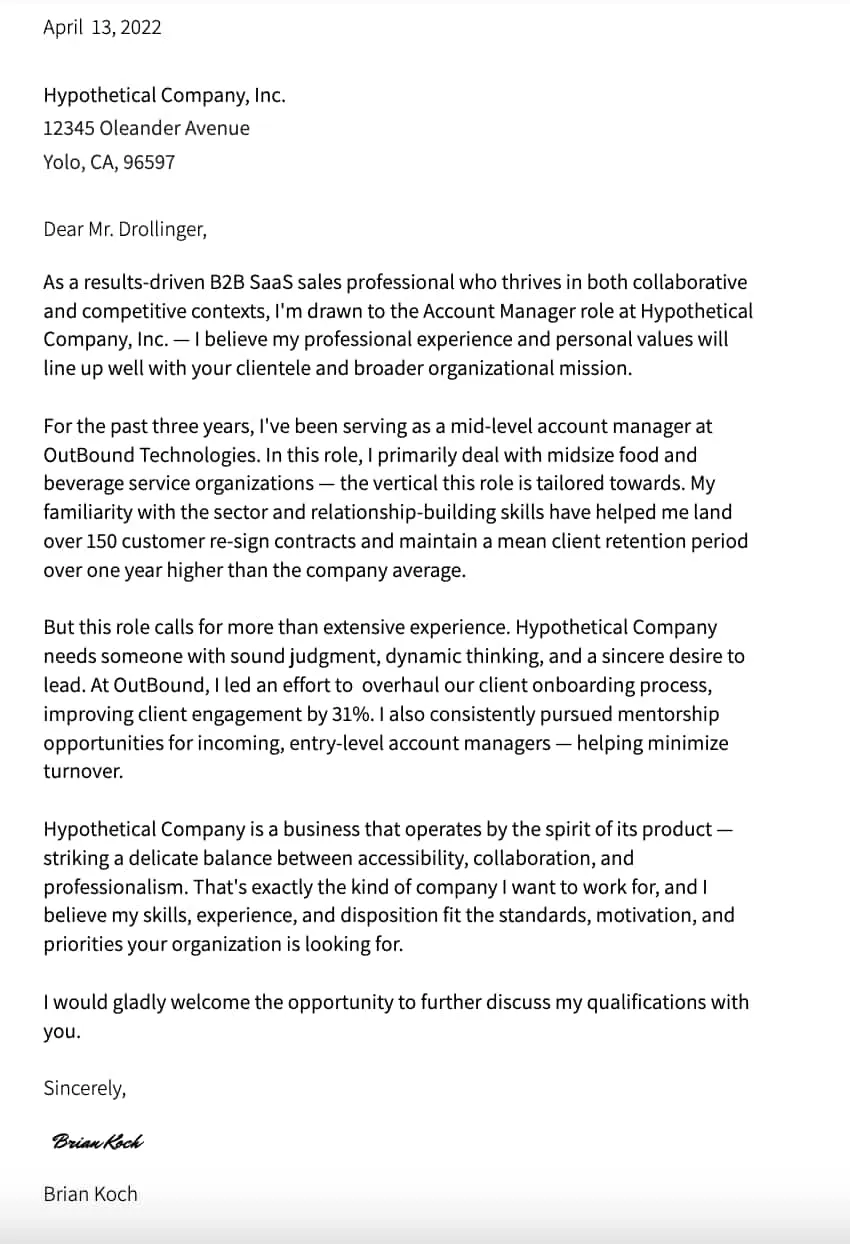
Before submitting your sales cover letter, proofread and edit it carefully. Check for any grammatical errors, spelling mistakes, and punctuation errors. Ensure that your sentences are clear, concise, and easy to understand. Read your letter aloud to catch any awkward phrasing or inconsistencies. Consider having a friend or a career counselor review your letter for feedback. Pay close attention to the tone of your letter, ensuring that it is professional and reflects your personality and enthusiasm. Proofreading and editing your cover letter is crucial for making a positive impression and demonstrating your attention to detail. A well-written and error-free cover letter shows that you care about the quality of your work and that you are a professional candidate. The cover letter is the first impression and you want to make it good.
Sales Cover Letter Examples
Reviewing sample sales cover letters can provide valuable guidance and inspiration for crafting your own. Search online for examples of cover letters for sales positions in your industry. Pay attention to how other candidates have highlighted their skills and achievements, and how they have tailored their letters to specific job descriptions. Use these examples as a starting point, but be sure to customize your own letter to reflect your unique qualifications and experiences. Adapt the examples to your own personal style, ensuring that your cover letter sounds authentic and reflects your personality. By studying sample cover letters, you can learn about different writing styles, formatting techniques, and the key elements that make a cover letter effective. Make sure that you customize the cover letter to fit your situation, and it shows who you are. Using examples is helpful but do not copy them.
